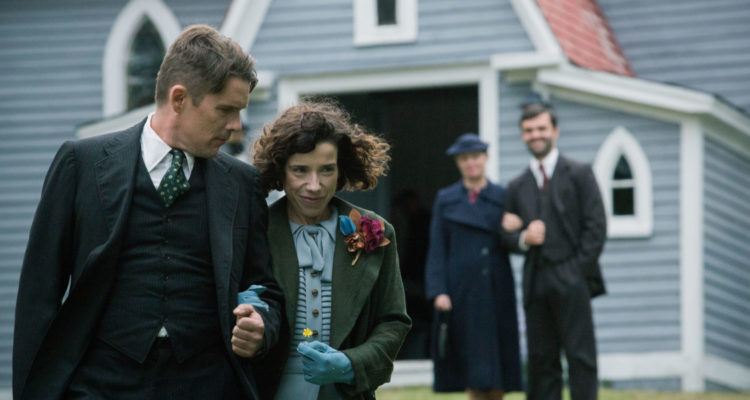Sweetly rendered, but too sentimental, Aisling Walsh’s “Maudie,” about famous Canadian folk art painter Maud Lewis features the always-reliable Sally Hawkins. She makes a compelling case for this under-sung character and intimate little movie. Unfortunately, she can’t carry the stilted weight of “Maudie” and the uneven film just can’t keep up with her terrific performance.
READ MORE: The 30 Most Anticipated Films Of The 2016 Toronto International Film Festival
Although not as well celebrated in mainstream art circles, Walsh’s painting career included many artistic highs. Most notable of which was the White House putting up two of her paintings in the hallways around the Oval Office. Her small-sized paintings carried along with them a melancholic sense of wonder. Whether it was her famous colorful flowers or miniature birds, the outdoors of her small Nova Scotian fishing town seemed to inspire her.
 If her compelling art was her exterior life to the public, her personal life wasn’t short of fascinating either. “Maudie” centers on the dysfunctional relationship between Maudie and her husband, Everett (Ethan Hawke). The pair experience a rocky start and Walsh’s movie showcases much of the verbal abuse that would mark and taint their relationship. It is then somewhat of a surprise when the pair get married and settle down together. Everett conveniently does change and they become a well-fitted match.
If her compelling art was her exterior life to the public, her personal life wasn’t short of fascinating either. “Maudie” centers on the dysfunctional relationship between Maudie and her husband, Everett (Ethan Hawke). The pair experience a rocky start and Walsh’s movie showcases much of the verbal abuse that would mark and taint their relationship. It is then somewhat of a surprise when the pair get married and settle down together. Everett conveniently does change and they become a well-fitted match.
Everett’s line of work is door-to-door fish peddling and in doing so Maude ends up getting the attention of a local visitor, a New York businesswoman (Kari Matchett) that is settling down in Canada for the summer. She sees Maude’s unusually simple art and instantly falls in love with it. This stroke of fortune, of course, begins to put her art on the map beyond just the Maritimes. Hawkins (“Happy Go-Lucky”) portrays Maude with a shy, slouched and restrained mannerism. It’s clear Hawkins is the highlight of the movie and the driving force behind what keeps the viewer engaged.
The same can’t be said about Hawke, a usually dependable actor, miscast in the role of Everett. He’s a man with inner demons that Maude tries to help manage, but the tonal inconsistencies of Walsh’s film are conspicuous. These wavering tenors often have much to do with the decision to focus on their love story instead of focusing on the much more satisfying topic: Maude’s art. What drove Maude to paint such exquisitely simple and remarkable work? Perhaps disinterested, the film never answers or really gives a clue to that question.
 Deeper in the picture, Maude’s battle with severe and chronic arthritis is hard to watch; the ailment debilitating her efforts to continue to paint in her later years. It’s in these scenes where Hawkins reveals another layer of depth to her character, as frustration mounts. But as the disease worsens the movie enters a by-the-books dramatic phase that feels clichéd and by-the-books.
Deeper in the picture, Maude’s battle with severe and chronic arthritis is hard to watch; the ailment debilitating her efforts to continue to paint in her later years. It’s in these scenes where Hawkins reveals another layer of depth to her character, as frustration mounts. But as the disease worsens the movie enters a by-the-books dramatic phase that feels clichéd and by-the-books.
Expertly shot by Guy Godfree, the Nova Scotian landscape is beautifully captured and the farm and fishing lands of the Maritimes feel authentic and uniquely Canadian. While pretty to look at clearly it’s not enough to win over the audience.
Ultimately, the labored romance overshadows Maude’s art, and the saccharinity throughout is just too sentimental to bear. There seems to be a tiny gem of a character study hidden inside Walsh’s film, but unfortunately “Maudie” and its at-odds tones just don’t work. It’s a film that one can actively admire, but its difficult to fully embrace. [C+]
Click here for our complete coverage of the 2016 Toronto International Film Festival.

